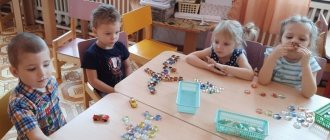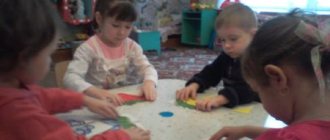Summary of a lesson on light engineering in the junior group of a preschool educational institution
Summary of the open lesson “Like our cat.”
Junior group Goal: Formation of a good attitude and love for animals. Educational areas: cognitive development, speech development, physical development. Program objectives: Educational:
- Introduce folklore works, enrich children's speech with words and lines of poetry;
— Teach children to assemble Lego models according to the model; Developmental:
- Develop children's curiosity, vocabulary, fine motor skills, thinking, logic, imagination and perception, the ability to pronounce onomatopoeia loudly and quietly;
Educational:
- To cultivate a kind attitude towards animals, a sense of beauty, an interest in playing with Lego constructors;
Equipment: toy - cat; bows - for breathing exercises, Lego constructor, algorithm for assembling models from Lego constructor. Expected results: - Can recite lines from a nursery rhyme by heart;
- Able to assemble Lego models according to the sample; - Use adjectives-definitions in speech: soft, fluffy. Progress of the lesson
Educator: Guys, look how many guests came to us today! Let's say hello, smile and give them a good mood (children say hello). Educator: Guys, another guest has come to us, but the guest is unusual. But guess who it is? “Soft paws, and the DAC’s paws have scratches.” Children: Cat. Educator: Well done, guys! The cat Vaska came to visit us (Sits on the windowsill) Look how beautiful he is, let's look at him. Educator: What does the cat have? (Children list: head, ears, eyes, nose, mouth, tail, paws, back). Educator: Guys, let's pat the cat on the back. (stroking) Educator: What kind of fur does the cat have? Margarita : Soft, fluffy. Educator: What do you think the cat likes to eat? Milana: Milk. Victor: Meat, fish. Educator: Guys, we are drinking milk, and the cat is lapping it with its tongue. (The teacher invites the children to show how the cat laps milk). Educator: Well done, guys! How well you told about the cat, but for some reason he is sad. He says that today is his birthday, but he is completely alone and has no one to celebrate the holiday with. Educator: Children, let's think about how we can congratulate and cheer up Vaska on his birthday so that he will be in a good mood. Pavel : Let's sing a song. Maxim : Let's dance. Kirill: Let's clap our hands. Educator: Guys, let's praise the cat and tell a nursery rhyme. (The teacher reads the nursery rhyme 2-3 times, accompanied by movements and repeats it with the children): Like our cat, (hands on the belt; turns the body left and right) The fur coat is very good, (we stroke ourselves from shoulder to wrist) Like a cat mustache, (“twist” the mustache) Of amazing beauty, (palms to the cheeks and shake your head left and right) Bold eyes, (blink your eyes) White teeth (show your teeth) Teacher: How well you praised our cat. He is very happy and look how he smiles. Educator: What does Kitty like to play with? (Children's answers) Educator: The cat loves to play with ribbons, now you and I will blow on them, the ribbons will move, and the cat will have fun. Take in more air through your nose and blow on the ribbons for a long, long time. And I'll see whose ribbon moves the most. Educator: Well done guys, Vaska is having fun and wants to play with us some more. Do you want to play with Vaska the cat? - (Yes) Educator: Vaska loves to play with mice. You will be a mouse, and the cat will catch you. Outdoor game "Cat and Mice". Educator: Children, what is not a single birthday without? (Children's answers) Educator: Let's prepare a treat for the cat's birthday table: cake, pastry, ice cream. (At the teacher’s suggestion, the children go to their workplaces). On the tables: a constructor and an algorithm for assembling models from a constructor. Children, using cards (an algorithm), collect treats for the cat from a construction set. - Whoever has a treat ready, place it on this plate. - Well done guys, how many sweets you got. - Vaska the cat, look how many treats you got, how hard the kids worked for you. Educator: Guys, let's go around the cat and start a round dance for him. (Children play the folk round dance game “Loaf” and loudly congratulate the cat. (Children shout “Congratulations!” 3 times). Teacher: Let’s set the table for our birthday boy and drink tea with treats together with the cat.
Photo of the practical part of the lesson
We recommend watching:
Summary of GCD in the junior group “How to take care of your teeth?” Summary of educational activities in the first junior group on the topic “Butterflies” using ICT Summary of a lesson on modeling in a junior group A lesson on describing toys in the junior group of a kindergarten
Similar articles:
Synopsis of a physical education lesson in the junior group “Spring Puddles”
Summary of a lesson on speech development and modeling in junior group 1
Summary of educational activities on cognitive and speech development in the 1st junior group
Summary of a lesson on health conservation for the second junior group
Summary of an art lesson in junior group 1
PEDAGOGICAL PROJECT FOR CHILDREN OF YOUNGER PRESCHOOL AGE (3-4 years old) “LEGO STEM - KIDS”
author: Balueva Lyudmila Nikolaevna
teacher Municipal Autonomous Preschool Educational Institution "Child Development Center "Dobryansky Kindergarten No. 15"
PEDAGOGICAL PROJECT FOR CHILDREN OF YOUNGER PRESCHOOL AGE (3-4 years old) “LEGO STEM - KIDS”
PEDAGOGICAL PROJECT FOR CHILDREN OF JUNIOR PRESCHOOL AGE (3-4 years)
» LEGO STEM – BABIES «
Educator: Balueva Lyudmila Nikolaevna
Relevance
Preschool education is the age period of formation of figurative forms of consciousness. One of these learning tools currently is LEGO constructors.
LEGO construction is one of the most modern areas of children’s development, widely using three-dimensional models of the real world and an object-based play environment for the child’s learning and development. LEGO allows children to learn through play and learn through play. The most important thing is to provide children with the opportunity to “experience” material that is interesting to them. By learning new things, children learn to express their attitude to what is happening. By constructing, they immerse themselves in a situation organized by adults. During educational activities, children become builders, architects and creators; while playing, they come up with and implement their ideas. In the process of activity, a variety of tasks are solved: psychological, cognitive activity develops. While traveling, children help their friends, rescue heroes from trouble, and learn interesting facts. In preparation for the trip, children construct, learn poems, and work with diagrams. At the same time, children develop creative imagination, communication skills, and curiosity. The main thing is that there are no spectators, there are only participants, and everyone participates with great desire. The knowledge children receive is relevant and necessary for them. And meaningful, interesting material is absorbed easily and forever.
Target:
development of initial skills in engineering, imagination, fine motor skills of children of primary preschool age in the process of playing with LEGO and testing of the partial modular program “STEM - education”, module - “LEGO - design”
Tasks:
— creating favorable conditions for the development of initial LEGO construction skills in preschool children;
— develop constructive thinking;
- develop children's imagination and curiosity;
- develop the ability to work with parts and convey the features of objects using LEGO constructors;
- develop fine motor skills of the fingers.
Starting with simple figures, the child moves further and further, and, seeing his successes, he becomes more self-confident and moves on to the next, more complex stage of learning.
Children playing with LEGO:
1. Develop fine motor skills of the hands, stimulating general speech development and mental abilities in the future.
2.Learn to navigate space correctly and quickly.
3. Expand their ideas about the world around them - about architecture, transport, landscape.
4.Develop attention, ability to concentrate, memory, thinking.
5.Learn to imagine, fantasize, and think creatively.
- They master the ability to mentally divide an object into its component parts and assemble a whole from the parts.
- They learn to communicate with each other, organize joint games, and respect their own and other people’s work.
Working with LEGO constructors allows children, in the form of educational play, to learn a lot of important things and develop skills necessary for later life.
There are three main types of design: by model, by conditions and by design.
-Construction from a model - when there is a ready-made model of what needs to be built (for example, an image or diagram of a house).
-When designing according to conditions, there is no sample, only the conditions that the building must meet are set (for example, a house for a dog should be small, and for a horse - large).
-Construction by design assumes that the child himself, without any external restrictions, will create an image of the future structure and embody it in the material that is at his disposal. This type of construction develops the child’s creative abilities better than others.
The interested attitude of parents plays an important role in the implementation of this project. In the modern world, almost every family has a LEGO constructor, but it is not used as a developmental material. To reveal the possibilities of LEGO to parents, during the implementation of the project such forms of work as consultations, open classes for parents, recommendations, etc. will be used.
The project is designed for classes 2 times a month. The duration of continuous direct educational activity for children from 3 to 4 years old is no more than 15 minutes.
Project participants:
- Group teachers
- Preschool children
- Parents
Organization and content of design training
First half of the year:
- learn to name the parts of a LEGO construction set (brick, big, smaller, small, beak, slide, bridge, etc.);
- teach the simplest analysis of constructed buildings (identify the shape, size, color of details);
— carry out the simplest design in accordance with given conditions (car gates);
- compare objects by length and width;
- enrich speech with phrases (the red path is long (wide));
- design according to the sample and conditions;
- distinguish by color and shape;
— develop hand-eye coordination when connecting construction parts, achieve precision in the process of operational actions.
Second semester:
— introduce new LEGO construction parts (car base, semicircle, oval);
- learn to reproduce a familiar object in a building, find its constructive solution;
- formalize your plan by preliminary naming the future building;
- develop and support the plan in the process of developing constructive activities, help to implement it;
— to develop the ability to use acquired knowledge in independent buildings according to plan.
Expected results:
- They are able to distinguish and name LEGO parts.
- They have the skills of simple analysis of constructed buildings (shape, size, color of parts).
- They have design skills: according to a model, according to conditions, according to the simplest visual diagrams.
- They have an idea of sensory standards (color, shape, size).
- Their spatial characteristics are distinguished in objects: “high - low”, “wide - narrow”, “long - short”.
- Know a variety of ways to fasten parts.
- They have the skills to concentrate attention and coordinate movements when connecting construction parts.
- They are able to reproduce a familiar object in a building, to formalize their plan by first naming the future building.
- They are able to develop and maintain a plan in the process of unfolding constructive activities.
- They are able to identify the object shown on the diagram and name its functions.
- They have design skills: according to a sample, according to conditions, according to design, according to drawings and visual diagrams.
Forms of work with parents:
- Workshop for parents “Let's play together!”
- Consultations:
- “How to play with your child at home using different types of construction”
- "Magic" bricks
- “Development of children’s cognitive and creative abilities in the process of constructive activity”
- "LEGO DUPLO educational toys"
- “LEGO construction as a means of developing spatial thinking in preschool children in preschool settings”
- Open viewings of GCD for parents.
- Photo exhibitions to present your own design models.
- Exhibitions of the best works of children.
Plan for working with children.
| Month | Subject | Goals |
| November | Introduction to LEGO construction | Introduce the LEGO constructor (brick, paw, beak). Reinforce knowledge of color and shape. |
| Pyramid | Learn to build simple buildings. Develop a caring attitude towards the designer. | |
| December | Bridge | Learn to build simple buildings. Develop a caring attitude towards the designer. |
| We will build a house in the forest | Develop creative imagination. Learn to imitate the sounds and movements of characters (bear, fox, hare). Learn to build a house from a LEGO constructor. | |
| January | Furniture for the room | Develop the ability to identify functional parts in objects. Learn to analyze a sample. |
| Design by Design | Reinforce acquired skills. Learn to think about the content of a future building in advance, name its theme, and give a general description. Develop creative initiative and independence. | |
| February | Bridge over the river | Learn to build a bridge and accurately connect building parts. |
| Truck | Learn how to create a simple model of a truck. Highlight the main parts and details. | |
| March | Car with trailer | Learn to build a car with a trailer. Develop design skills. |
| Fire engine | Introduce the profession of a firefighter. Learn to build a fire truck. | |
| April | Rocket | Talk about space. Learn to build a rocket. |
| Design by Design | Reinforce acquired skills. Learn to think about the content of a future building in advance, name its theme, and give a general description. Develop creative initiative and independence. | |
| May | Playground | Show the children's playground. Build a sandbox and stairs. |
| Slide for the kids | Continue to introduce the children's playground. Develop memory and observation skills. | |
| Design by Design | Reinforce acquired skills. Learn to think about the content of a future building in advance, name its theme, and give a general description. Develop creative initiative and independence. | |
| As a result, the child may: | ||
| know |
| |
| be able to |
| |
| have an idea |
| |



